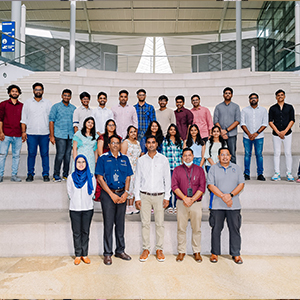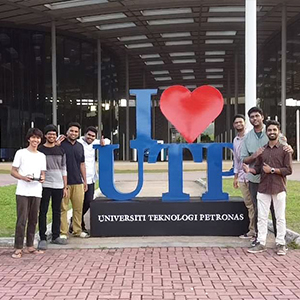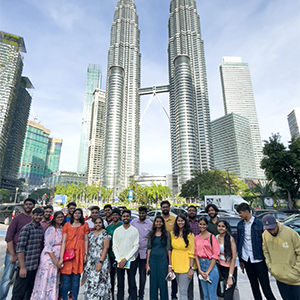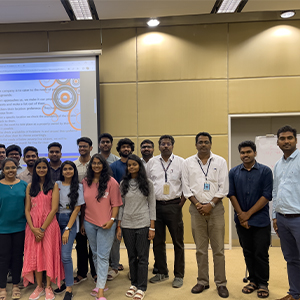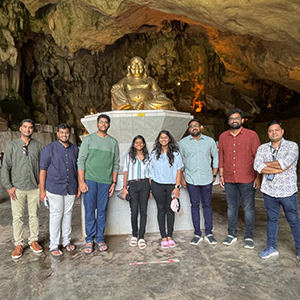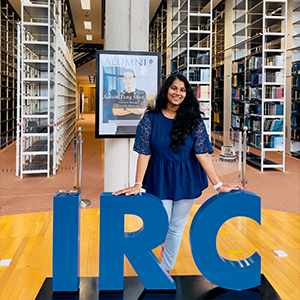All Management News
- Dr Koyel Chakravarty July 4, 2022
- SRMAP B tech Entrance Test on June 12 July 4, 2022
Chronicle – June 09
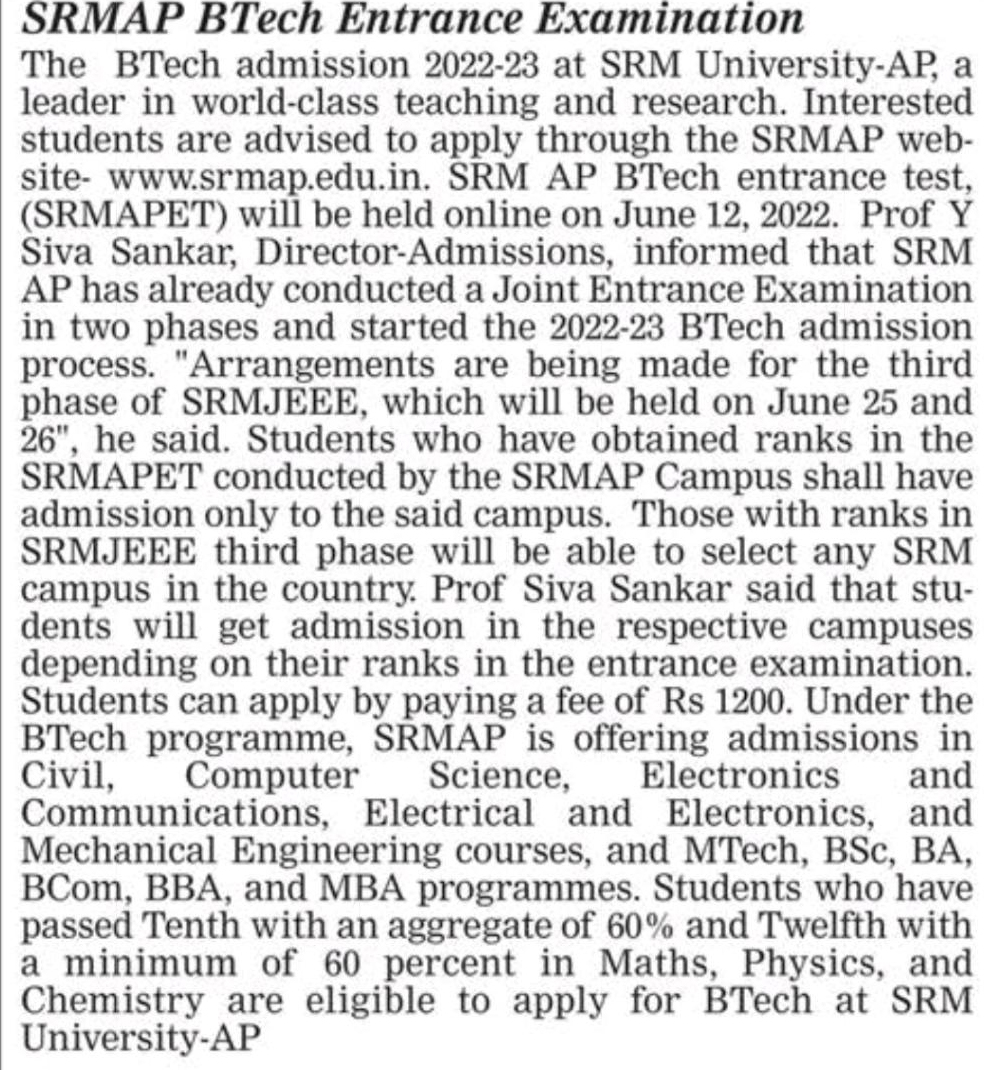
Daily-Kesari – June 08
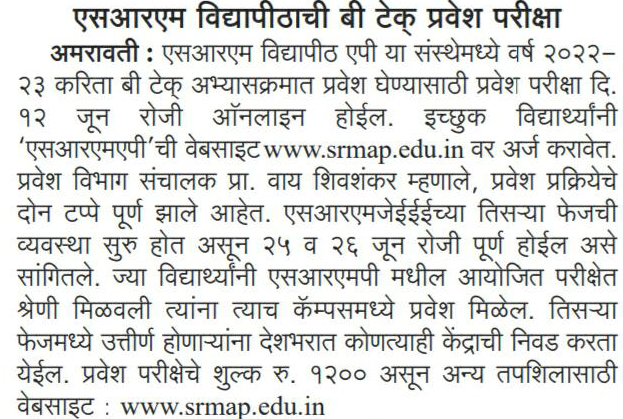
New-Indian-Express – June 06
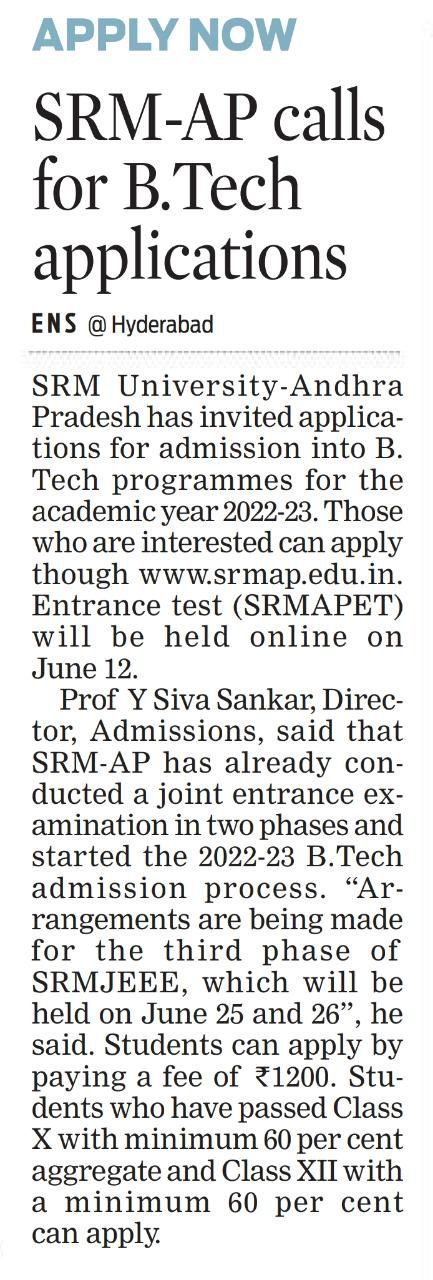
The-Hindu – June 05
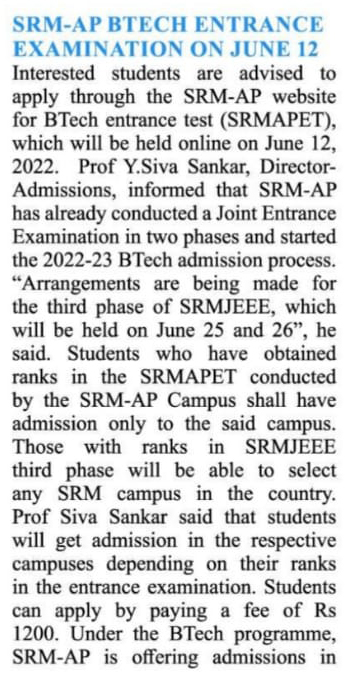
Hans-India – June 04
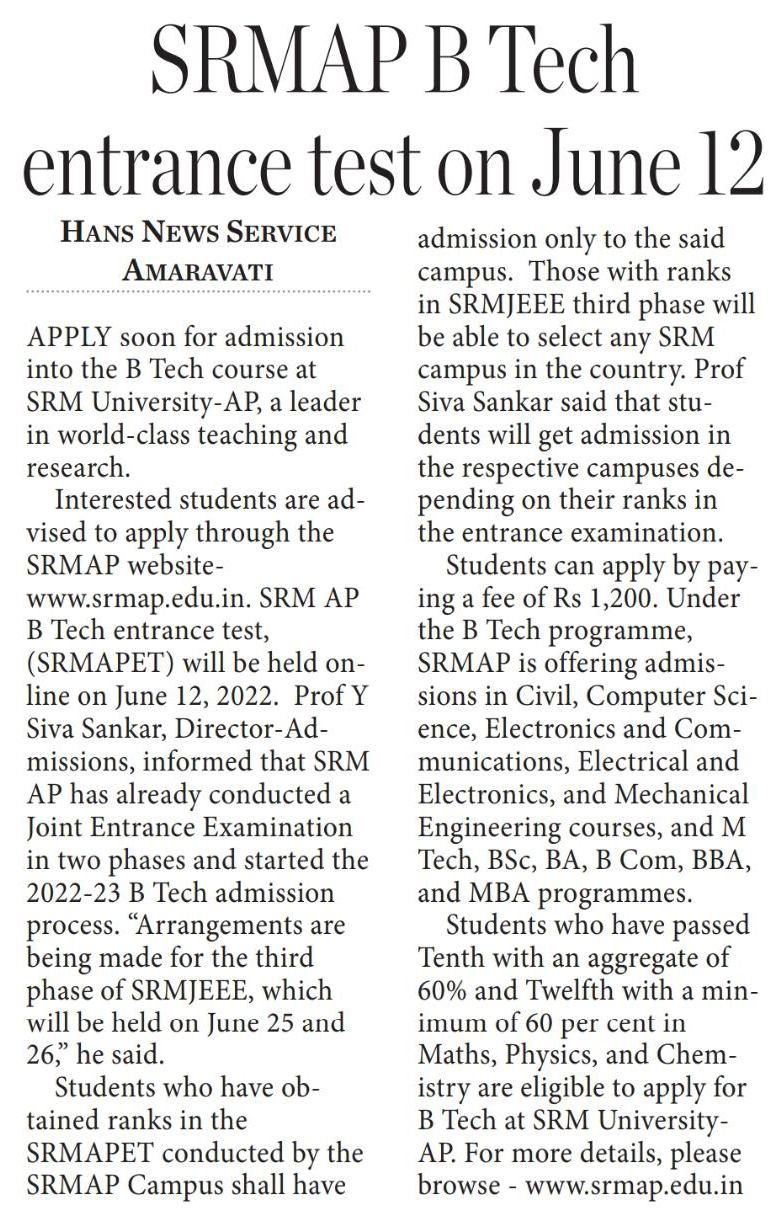
Sakshi – June 04
Continue reading →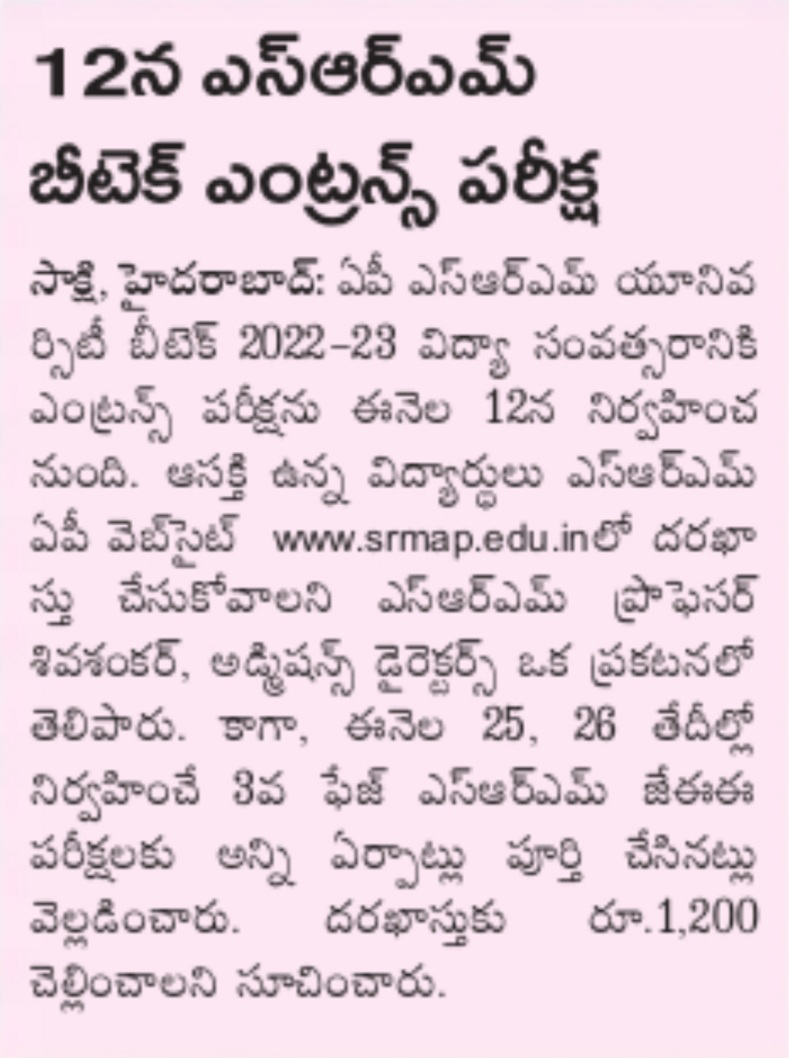
- Dr Pankaj Pathak published articles on sustainable waste management July 2, 2022
Dr Pankaj Pathak from the Department of Environmental Science has been keenly involved in research studies involving solid waste management and the effective conversion of wastes to energy. Her latest research publication ‘A comprehensive review on integrative approach for sustainable management of plastic waste and its associated externalities’ in the journal Science of the Total Environment (Impact Factor: 10.973) proposes enhanced solution for the sustainable management of plastic wastes. The article was published in collaboration with her PhD Scholar MSSR Tejaswini, Prof Sreeram Ramakrishna from the Centre for Nanofibers and Nanotechnology, National University of Singapore and Dr P Sankar Ganesh from BITS Pilani, Hyderabad.
Abstract of the Research
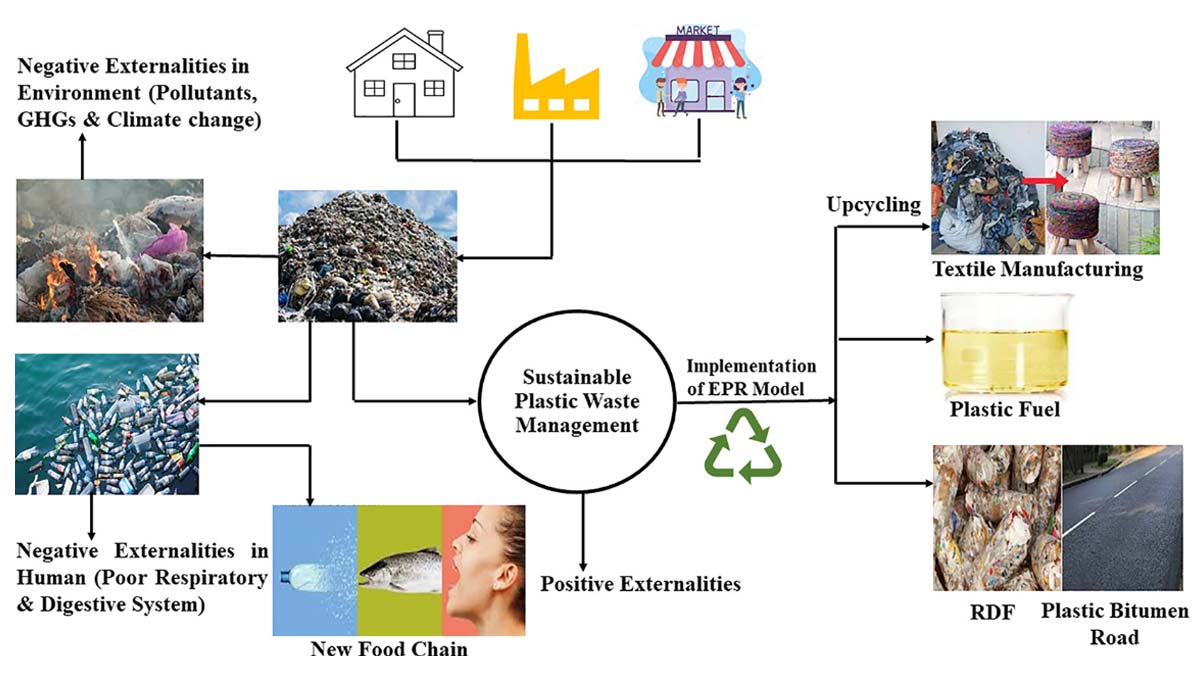
The management of post-consumer discarded plastic wastes (PCPW) creates new challenges in developing countries due to the lack of amenities, technological interventions, and associated negative environmental externalities. The fate of untreated recyclable and non-recyclable plastic wastes lies in open dumping along with other solid waste, and improper management leads to environmental externalities such as pollution, global climate change, and health issues. Additionally, open dumping upsurges the emerging microplastics and nano plastics (MNPs) contaminants. The externalities depend on the waste generating sources (household, industries, commercial), waste composition, and its characteristics. However, urban mining can minimize environmental externalities where waste plastics can convert into potential anthropogenic resources and also helps in achieving the target of sustainable development goals (SDGs 11 & 12). Moreover, various treatment technologies that help in the sustainable utilization of plastic wastes are extensively reviewed in this study and evaluate the costs benefits arising during various stages of treating plastic waste through recycling (R), incineration (I), and landfilling (L). The recycling of plastic waste has demonstrated the lowest impact on global warming potential (GWP) and total energy use (TEU), followed by landfilling and incineration (R < L < I). Nevertheless, when energy is recovered from inert (non-recyclable) plastic waste in the form of fuel or by its utilization in construction purposes, the environmental impacts are more negligible (Incineration < Landfilling). Therefore, this study determines the significance of circular economy with legislative approach and standards on plastic waste management, which help in reducing environmental externalities besides yielding a secondary resource as energy and materials through urban mining. A sustainable plastic waste management (SPWM) model is proposed for developing countries to convert plastic waste into resources and use it as a sustainable tool in urban mining.
Yet another article, ‘Comprehensive technological assessment for different treatment methods of leather tannery wastewater’, co- published by Dr Pankaj Pathak along with a group of other researchers was featured in the journal Environmental Science and Pollution Research having an Impact Factor of 5.19. The work offers some exhaustive observations and recommendations that could be helpful in the industry to manage tannery wastewater and recirculate the water in a sustainable manner.
Abstract of the Research
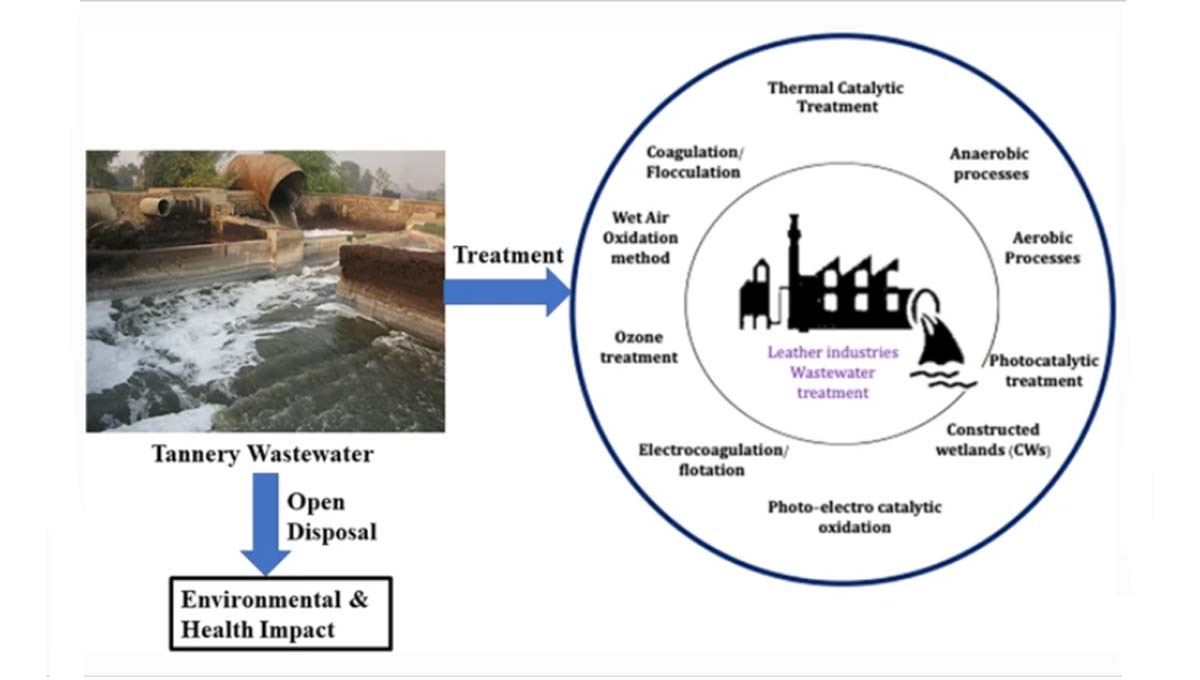
The leather-making process necessitates large amounts of water and consequently generates tons of liquid waste as leather tannery wastewater (TWW) is disposed of directly in the open environment. Open disposal of untreated TWW into the natural environment causes an accumulation of various polluting compounds, including heavy metals, dyes, suspended solids inorganic matter, biocides, oils, tannins, and other toxic chemicals. It thus poses potential hazards to the environment and human health. This study primarily focuses on providing in-depth insight into the characteristics, treatment strategies, and regulatory frameworks for managing TWW in leather processing industries. Different technologies of conventional physico-chemical (equalization, coagulation, and adsorption), advanced approaches (Fenton oxidation, ozonation, cavitation), thermo-catalytic and biological treatments available to treat TWW, and their integrative approaches were also highlighted. This review also sheds light on the most frequently applied technologies to reduce contaminant load from TWW though there are several limitations associated with it such as being ineffective for large quantities of TWW, waste generation during treatment, and high operational and maintenance (O&M) costs. It is concluded that the sustainable alternatives applied in the current TWW technologies can minimize O&M costs and recirculate the treated water in the environment. The exhaustive observations and recommendations presented in this article are helpful in the industry to manage TWW and recirculate the water in a sustainable manner.
- Dr Rajoshree Chatterjee July 2, 2022
- Dr Vinay Ch July 2, 2022
- Dr Sujith Kalluri elected as the Honorary Secretary of IETE, Vijayawada Chapter July 1, 2022
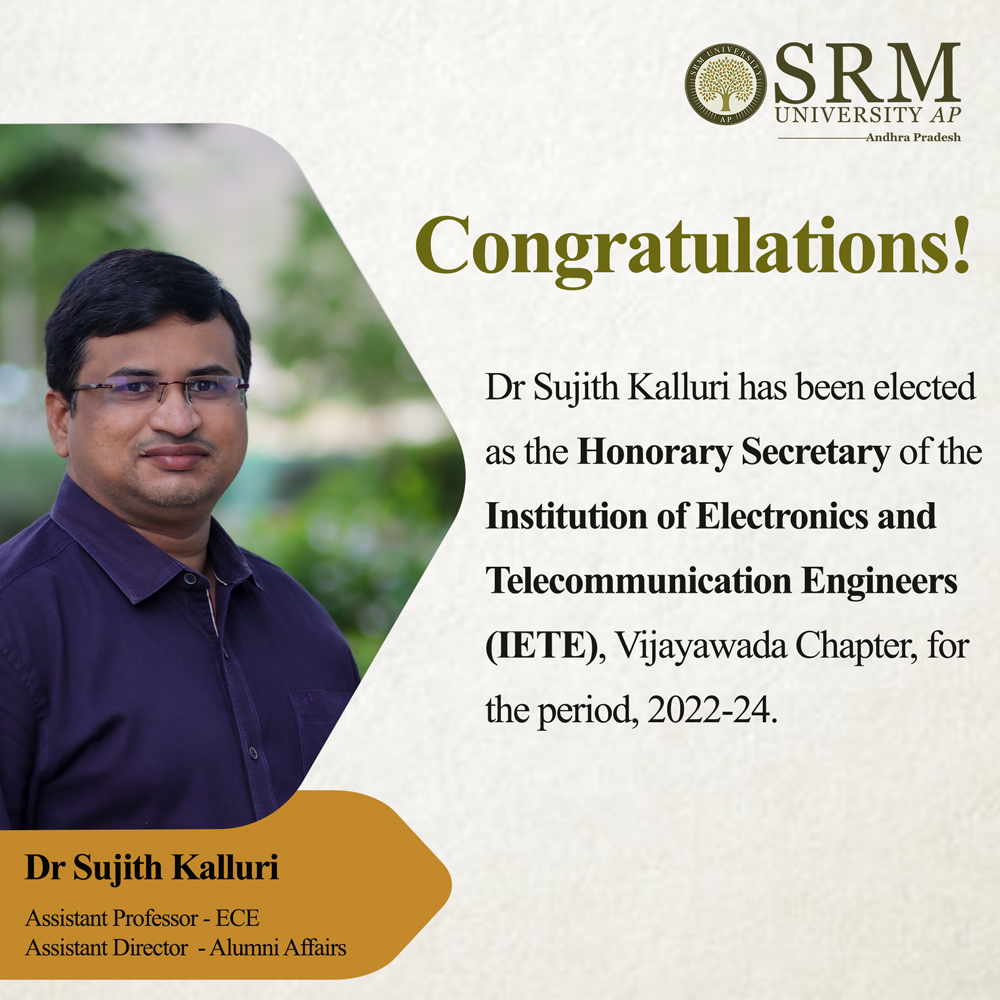
Dr Sujith Kalluri, Assistant Professor of the Department of Electronics and Communication Engineering, has been elected as the Honorary Secretary of the Institution of Electronics and Telecommunication Engineers (IETE), Vijayawada Chapter for the period, 2022-24. Dr Kalluri is one of the young and spirited faces of SRM University-AP who has already borne out his charisma and capacity as an influential teacher and passionate researcher. He is also the Assistant Director of Alumni Affairs, a forum that oversees and follows up on the activities of students graduating from the University.
SRM University-AP is proud and privileged to celebrate this achievement as Dr Kalluri is on a roll to make greater strides in his professional career. Being the youngest officer to assume the role of secretary at the office of IETE Vijayawada makes this even more special an accomplishment. “I am indeed privileged to assume the role of Honorary Secretary of the Institution of Electronics and Telecommunication Engineers (IETE) Vijayawada Chapter. This is an incredible opportunity to collaborate with various academic and industrial experts in relevant domains” he exclaimed.
IETE is India’s leading recognised professional society devoted to the advancement of Science and Technology in electronics, telecommunications and IT. The institution provides leadership in scientific and technical areas of direct importance to the national development and economy. The government of India has recognised IETE as a Scientific and Industrial Research Organisation (SIRO). Dr Kalluri intends to utilise this opportunity to conduct technical events, such as conferences, symposia, and exhibitions, that would benefit the student community to be industry ready and acquaint with different professional networking circles.
Dr Kalluri is an active member of the World Academic-Industry Research Collaboration Organization (WAIRCO), the Institute of Electrical and Electronics Engineers (IEEE), and the Australian Nanotechnology Network (ANN) among many others. “It is my passion to be associated with professional bodies. I take this as an exciting opportunity to build my leadership and organising skills that could facilitate my professional growth” remarked Dr Kalluri. “I would also like to convey my gratitude to the management and leadership teams at SRM University-AP who have always supported me in terms of availing such opportunities” he maintained.
- Hybrid relay – IRS-aided wireless IoT network for 6G communications July 1, 2022
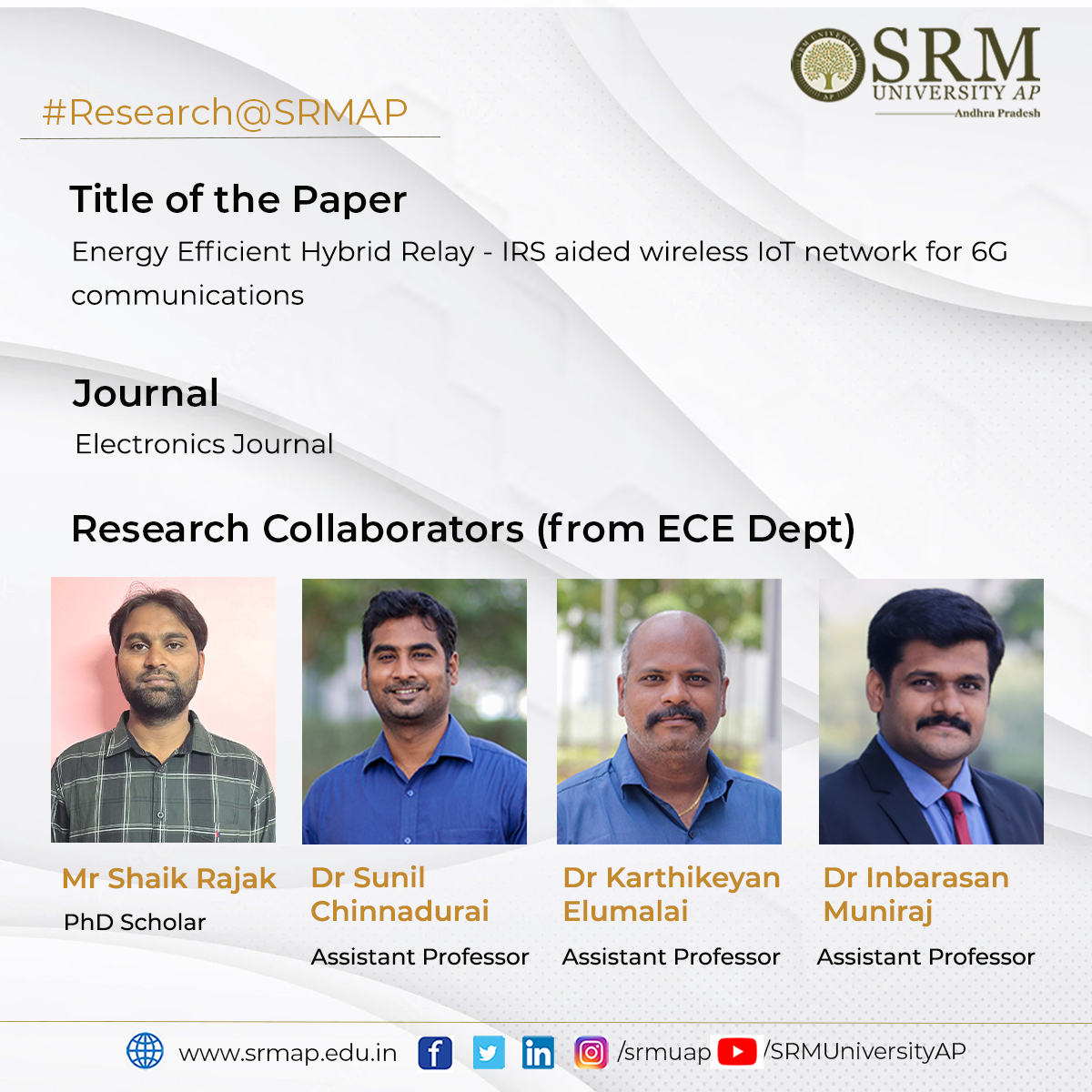
The Department of Electronics and Communication Engineering has come out with yet another rewarding publication, “Energy-Efficient Hybrid Relay – IRS aided wireless IoT network for 6G communications”, in the Electronics Journal, with Impact Factor 2.4. The article was published by Mr Rajak Shaik, PhD Scholar, in collaboration with the faculty members; Dr Sunil Chinnadurai, Dr Karthikeyan Elumalai and Dr Inbarasan Muniraj. This research is the first of its kind, which examines and compares the impact of relay-aided, IRS-aided, and novel hybrid relay-IRS-aided wireless IoT networks for 6G communications in terms of Energy Efficiency.
The article examines Energy Efficiency as a function of user distance and various SNR (Signal-to-noise ratio) values. The Energy Efficiency with fixed and varying numbers of IRS elements is analysed for the proposed IoT network. The results show that the proposed hybrid relay-IRS-assisted IoT network outperforms both the conventional relay and IRS-aided wireless IoT networks. The hybrid relay-IRS-aided IoT network can fulfil the requirements of high data rate, reliable data transfer, and large bandwidth needed for 6G communications. The multiple IRS concept can also be used in 6G communications at high SNR values to reduce both the cost and additional power consumption of wireless IoT networks. Their future research plan also includes the real-time implementations to improve the energy efficiency for wireless IoT networks with IRS in 6G communications.
Abstract of the Research
Intelligent Reflecting Surfaces (IRS) have been recognized as presenting a highly energy-efficient and optimal solution for future fast-growing 6G communication systems by reflecting the incident signal towards the receiver. A large number of Internet of Things (IoT) devices are distributed randomly in order to serve users while providing a high data rate, seamless data transfer, and Quality of Service (QoS). The major challenge in satisfying the above requirements is the energy consumed by the IoT network. Hence, in this paper, we examine the energy efficiency (EE) of a hybrid relay-IRS-aided wireless IoT network for 6G communications. In our analysis, we study the EE performance of IRS-aided and DF relay-aided IoT networks separately, as well as a hybrid relay-IRS-aided IoT network. Our numerical results showed that the EE of the hybrid relay-IRS-aided system has better performance than both the conventional relay and the IRS-aided IoT network. Furthermore, we realized that the multiple IRS blocks can beat the relay in a high SNR regime, which results in lower hardware costs and reduced power consumption.
Continue reading → - Global Immersion at UTP, Malaysia July 1, 2022
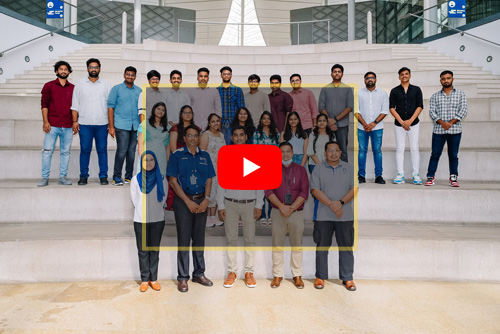 21 students from the first batch of students from SRM University-AP, Andhra Pradesh, has completed the Familiarisation Programme at Universiti Teknologi PETRONAS (UTP), Malaysia in the month of June. This is part of Global Immersion facilitated by the Office of International Relations and Higher Studies at SRM AP.
21 students from the first batch of students from SRM University-AP, Andhra Pradesh, has completed the Familiarisation Programme at Universiti Teknologi PETRONAS (UTP), Malaysia in the month of June. This is part of Global Immersion facilitated by the Office of International Relations and Higher Studies at SRM AP.Students and faculty mentors from SRM AP participated in several on and off-campus activities such as campus tours, cultural exchange, and recreational activities in UTP Malaysia. There were educational trips to Kuala Lumpur and PETRONAS Twin Towers. The students were accompanied by Dr Sunil Chinnadurai, Assistant Professor at SRM University-AP.
In the five-day programme, SRM University-AP students enrolled in two non-credited courses – Introduction to Technical Reporting & Latex Scripting and Data Analysis with R Statistics. The students were introduced to UTP’s facilities, programmes, research capabilities, and campus life as a part of the Familiarisation Programme.
UTP Centre for Student Development (CSD) thanked SRM University-AP for entrusting them to provide our students with a global experience by participating in this programme.
“I had both educational and fun-filled activities throughout the week in Malaysia”– Samardh, 3rd year, CSE
“Thanks to the office of IR and HS for giving us exposure abroad”– Laasya, 3rd year, BBA
“Short courses made big difference in the thinking and learning process of students”– Bharath, 3rd year, CSE
“UTP is a place of cheer, civility, and friendship. I thank SRM AP for this wonderful opportunity”– Sukhdev, 3rd year, CSE
Continue reading → - Two paper presentations at the 4th International Conference on Energy, Power, and Environment July 1, 2022
Two research papers from the Department of Computer Science and Engineering were presented at the 4th International Conference on Energy, Power, and Environment held from April 29 to May 1, 2022. Assistance professor V M Manikandan and three BTech students participated in the conference organised by NIT Meghalaya, India. The papers will be published in IEEE Xplore Digital Library (Scopus Indexed).
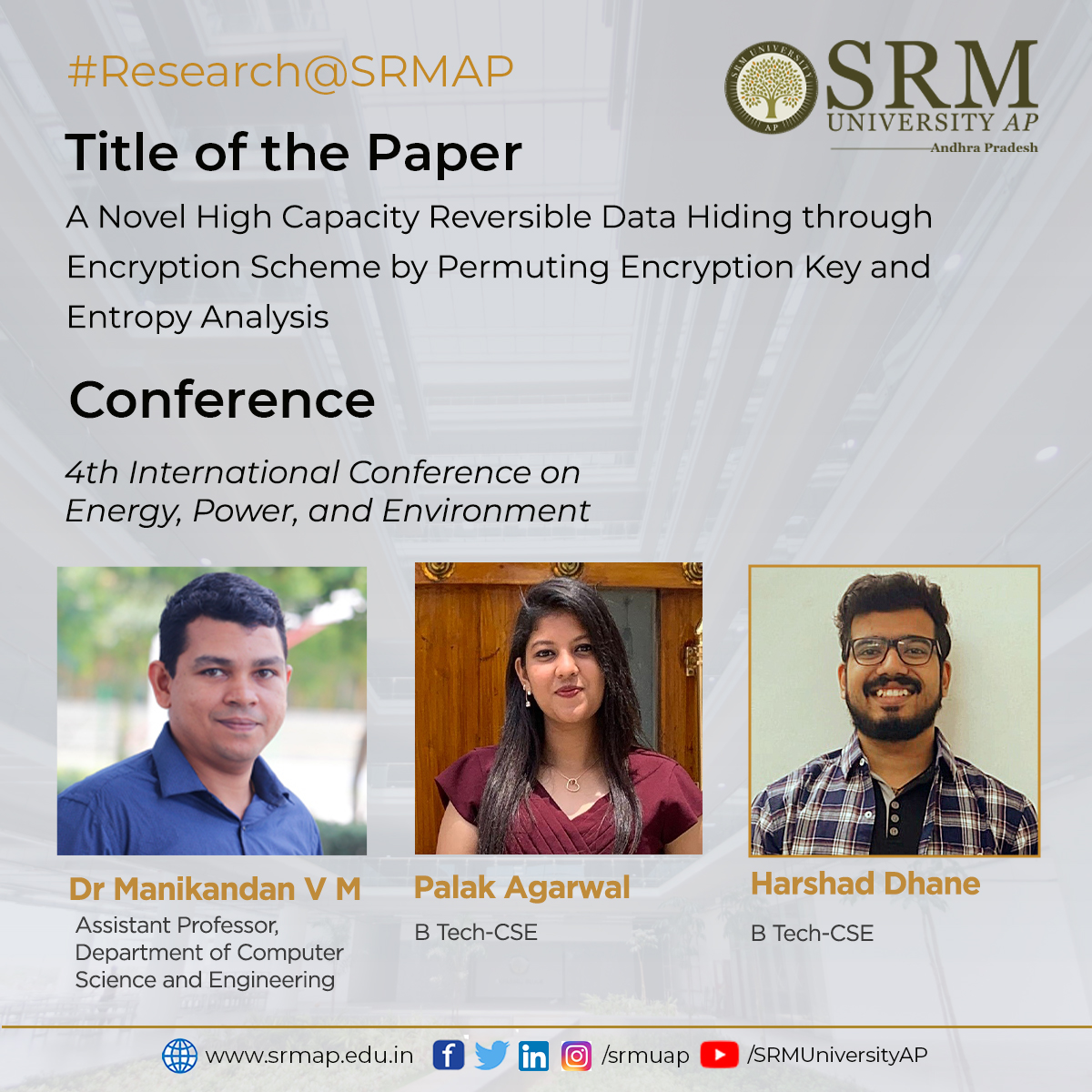 Third-year BTech CSE student Harshad Dhane presented the paper A Novel High Capacity Reversible Data Hiding through Encryption Scheme by Permuting Encryption Key and Entropy Analysis, co-authored by Palak Agarwal, third-year BTech student, and Dr V M Manikandan. The reversible data hiding scheme proposed by the research can be used in the healthcare sector to transmit electronic patient reports along with medical images. Improving the embedding rate of the reversible data hiding is the further plan of the researchers.
Third-year BTech CSE student Harshad Dhane presented the paper A Novel High Capacity Reversible Data Hiding through Encryption Scheme by Permuting Encryption Key and Entropy Analysis, co-authored by Palak Agarwal, third-year BTech student, and Dr V M Manikandan. The reversible data hiding scheme proposed by the research can be used in the healthcare sector to transmit electronic patient reports along with medical images. Improving the embedding rate of the reversible data hiding is the further plan of the researchers.Explanation of the research
A Reversible Data Hiding Through Encryption (RDTE) scheme will consider an original image and a sequence of bits as the input and generate an encrypted image as the output. This encrypted image will be able to transmit through the network securely, and the authorized receiver can take out the hidden details along with the restoration of the actual image. This paper proposes a new RDTE scheme with a good rate of embedding without any issues during the restoration of the original image. The researchers used the well-known RC4 pseudo-random generator for the image encryption and performed data hiding during block-wise image encryption. In the proposed scheme, the original image is considered non-overlapping blocks of size BXB pixels, and these blocks will be encrypted using a sequence of pseudo-random integers. During the RDTE process, all the possible unique permutations of the encryption key, K, will be generated, say (K0, K1,…, KN). Further, the sender will be capable of embedding one integer value from the set {0, 1, …,N} in a selected image block. A selected block will be encrypted using the pseudo-random sequence of integers using the key K_Q to embed the integer Q in the selected block. The proposed scheme prefers to select keys with unique characters with sufficient length to ensure the maximum embedding capacity. The message extraction and image restoration are performed by analysing the entropy measure from each block after attempting the decryption.
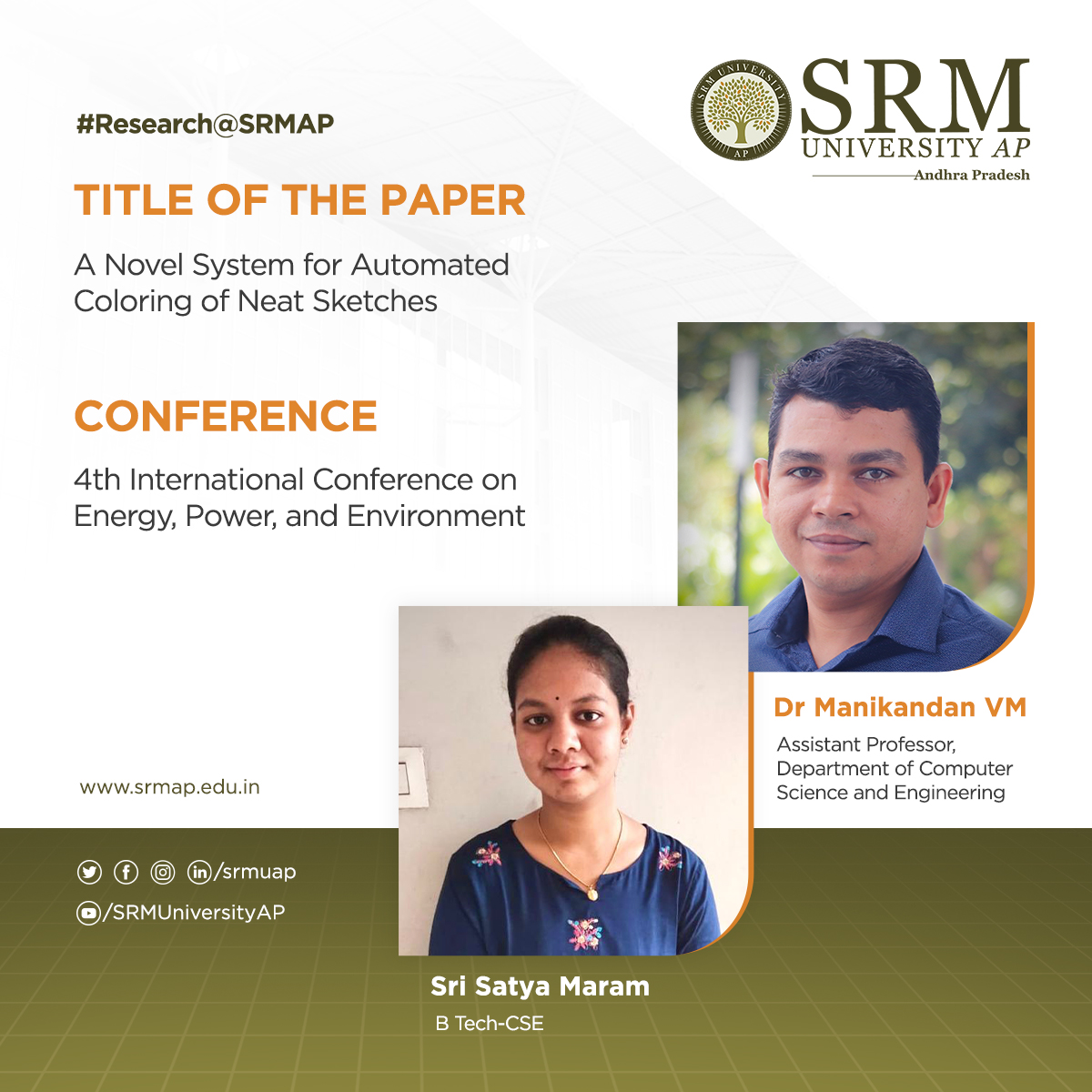 The paper presented by second year BTech CSE student Sri Satya Maram is titled A Novel System for Automated Coloring of Neat Sketches and was co-authored by Dr V M Manikandan. The research introduces a new algorithm to colour a given neat sketch. The proposed algorithm can be used to colour drawings to create animated movies or to colour the designs developed by the designers. The researchers plan to develop artistic features on the coloured image for better visual appearance.
The paper presented by second year BTech CSE student Sri Satya Maram is titled A Novel System for Automated Coloring of Neat Sketches and was co-authored by Dr V M Manikandan. The research introduces a new algorithm to colour a given neat sketch. The proposed algorithm can be used to colour drawings to create animated movies or to colour the designs developed by the designers. The researchers plan to develop artistic features on the coloured image for better visual appearance.Explanation of the research
The process of colouring neat sketches is a significant activity when making animated movies or for better visualization in computer modelling. The colour filling tools are widely available in almost all the image/video editing software, which will help us pick a colour from a colour palette and can be filled in a selected region. This process is known as flat colouring. The flat colouring process has several challenges. One of the significant challenges is that the colour may leak from the selected regions to neighbouring regions if there are some small openings on the contours. The second concern while using flat colouring is that the designated areas will be filled entirely with the same colour, so the drawing will not have an artistic look. The research proposes a new software application that will take a neat sketch as the input, and the system will generate a coloured drawing as the output. In the proposed scheme, the researchers have converted the given sketch to a grayscale or binary image and applied image dilation operation to fill the small open spaces in the contours (if any). Further, the closed regions are identified and coloured with a predefined set of colours or random colour combinations. While colouring the regions, the proposed system will ensure that the adjacent regions will not be coloured with the same colours. A number of sketches have been considered during the experimental study, and the results are validated manually.
Continue reading → - Computational intelligence and the healthcare system June 30, 2022
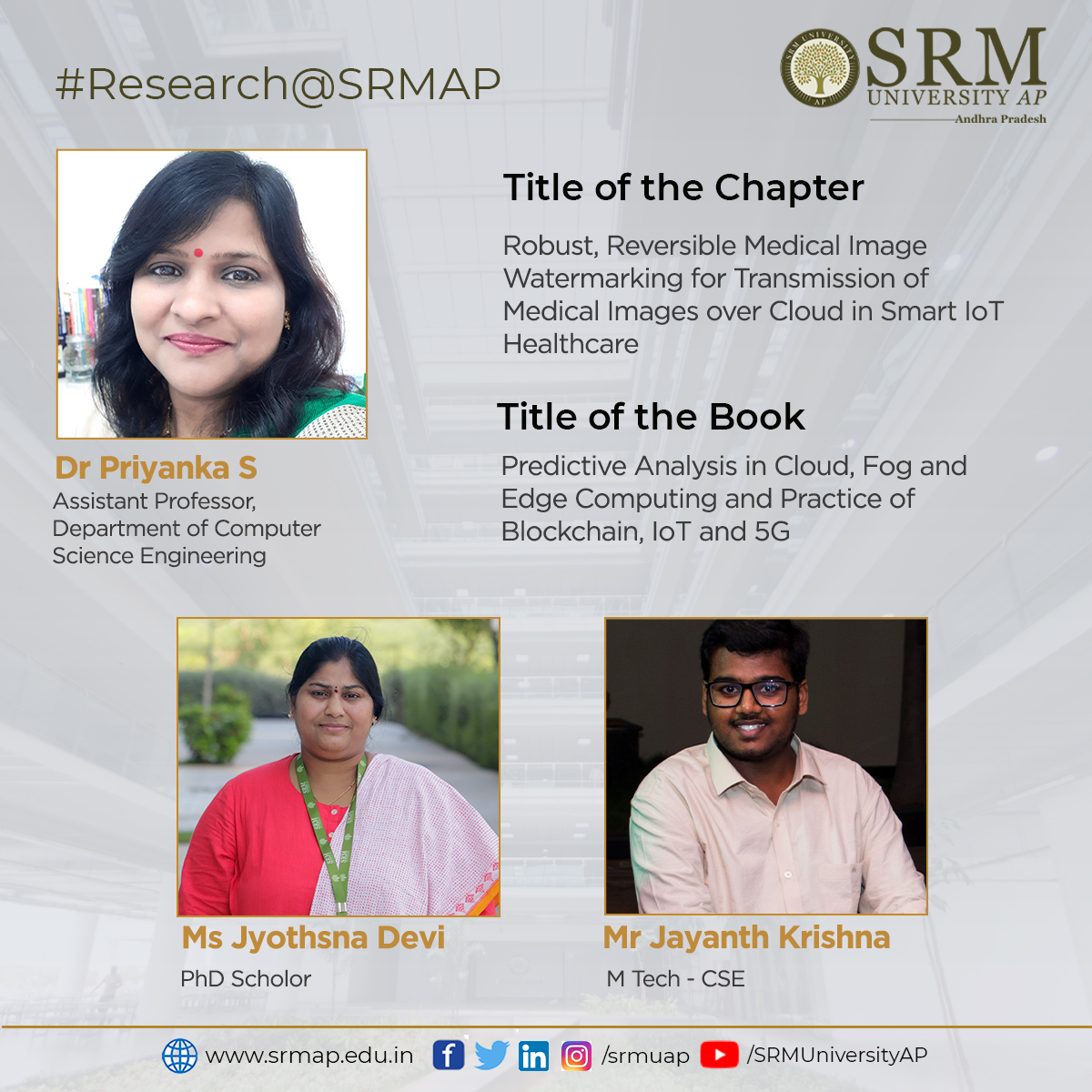 Computational and artificial intelligence is enjoying an unparalleled relevance in the modern world. They improve people’s lives and are highly anticipated in the healthcare industry. Research in this domain is hugely appreciated by the contemporary world, considering its potential to create revolutionary changes in the health care system. The Department of Computer Science and Engineering is delighted to inform you that the paper Robust, Reversible Medical Image Watermarking for Transmission of Medical Images over Cloud in Smart IoT Healthcare has been accepted for publishing as a chapter in the book Predictive Analysis in Cloud, Fog and Edge Computing and Practice of Blockchain, IoT and 5G.
Computational and artificial intelligence is enjoying an unparalleled relevance in the modern world. They improve people’s lives and are highly anticipated in the healthcare industry. Research in this domain is hugely appreciated by the contemporary world, considering its potential to create revolutionary changes in the health care system. The Department of Computer Science and Engineering is delighted to inform you that the paper Robust, Reversible Medical Image Watermarking for Transmission of Medical Images over Cloud in Smart IoT Healthcare has been accepted for publishing as a chapter in the book Predictive Analysis in Cloud, Fog and Edge Computing and Practice of Blockchain, IoT and 5G.The paper was submitted by Assistant Professor Dr Priyanka S, her PhD student Ms Jyothsna Devi, and MTech student Mr Jayant Krishna. The book chapter for the edited book is entitled Predictive Data Security using Ai – Insights and Issues of Blockchain, IoT, and DevOps and is published by Springer Nature. It is a part of the book series, Studies in Computational Intelligence, indexed by SCOPUS.
The book Studies in Computational Intelligence targets to bring together researchers and practitioners in computational intelligence and AI technology, especially those related to the areas of Machine learning, blockchain, multimedia using AI, smart IoT environment and email spam and online surveys, and many more recent emerging fields. The research work mainly provides highly secure, robust medical image transmission over the cloud in a smart IoT healthcare environment to ensure high embedding capacity and integrity.
This book’s target audience comprises professionals and researchers working in the field of computational intelligence and AI for health services in a smart environment. The book will attract Engineers (computer, industrial, software, and others), health care scholars, and information scientists since it caters to their interests.
Continue reading →


